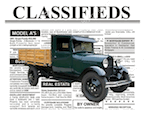Tech Q&A - Chassis - Other
CHASSIS LUBRICATION CHART![[Image]](images/new2.gif)
Question:
Where can I find a chassis lubrication chart?
Answer:
The chassis lubrication chart was first published in the Ford Service Bulletins, Volume 9 Number 1, January 1928, on the last page.
Click here to see the chart. This chart is available from most Model A Ford parts vendors.
CHASSIS SERIAL NUMBER (VIN)
Question:
Where can I find the chassis number or Vehicle Identification Number on the Model A Frame?
Answer:
When the Model A was being assembled at the Ford plant, after the new engine was lowered into the chassis, a worker would stamp that engine number on top of the frame. Unfortunately, on a completed car, the number cannot be seen because the body webbing and running board splash apron is on top of it. There are two places where the serial number has been seen. The first is on top of the frame, just to the rear of the front body bolt. The second places is also on top, but near the second body bolt location.
Many years of dirt and grime and rust may have accumulated on top of the frame, so some gentle scraping and cleaning may reveal the number. If the body is off the frame, find the front-most body bolt hole on the left side of the frame and clean a 12" section to the rear of that hole. If you don't see any number, clean another 12" section opposite the next body bolts holes. Don't be surprised if the number doesn't match the current engine number in the vehicle. It was common practice in the 1930s and 1940s to replace rather than rebuild Model A engines.
Click here to view a photo which may help you locate the original engine number stamped on top of the frame. -- Rick Black, Las Cruces NM 2023
CLOCKWISE or COUNTERCLOCKWISE
Question:
Please set the record straight about Clockwise, Counter Clockwise, and Anti Clockwise in the description of shock absorber motion.
Answer:
Your letter of Nov 19th has been faxed to me and you are absolutely correct, your dictionary is also correct and you have not been misinformed all these years. My reference to "CW" as counter clockwise in my shock answer in the Nov/Dec Restorer was an oversight and typo on my part. Like you, I have known all my life that "CW" stands for clockwise and "CCW" stands for counter clockwise. Using "AC" anti-clockwise was Henry's doing. -- Lyle Meek, 1997 Technical Director
FRAME SAG
Question:
We need ANY information on straightening a sagging frame. We have E-Mail, of course, as you can tell and also have a FAX number: 208-255-2131. We also have lots of back issues of "The Restorer" and we believe that there was an article about this at one time. Do you have the issue that was in?
Answer:
The article is "Frame straightening - the Shade Tree Way" and it's in the March-Apr 1975 issue of The Restorer on page 15. -- Les Andrews, 1998 Technical Director
GASKETS
Question:
Can I remove the axle housings from each side and just replace the gaskets (same for torque tube?) My 1931 deluxe coupe's rear end is fine except for leaking gaskets at the pumpkin.
Answer:
To replace the Banjo gaskets and Torque Tube gasket you need to remove (with the use of a spring spreader) the complete rear end assembly from the car. If you have a copy of the "Model A Ford Mechanics Handbook" it gives complete instructions how to remove the rear end assembly from the car. The torque tube and axle housings must be completely removed to install the gaskets. Be sure to note how many old gaskets are on each side of the banjo as this is important in adjusting bearing load. There may be more on one side than the other. -- Les Andrews, 1998 Technical Director
HUBS
Question:
We have a Model "A" shop that three of us have started. One of our group is an excellent mechanic and really knows Model A work. However, one of the things that is baffling us is rear hubs. When the key way gets wallered out one could turn the hub 90 degrees and recut a key way. I found a description in a book of the taper on the axle, and had a mandrel made. It was not the correct taper! What is the correct taper? Having this info would give us the ability to salvage a few more hubs. After all they are getting scarce.
Answer:
I finally found the Ford engineering drawing on the rear axle. It calls for a taper of 1-1/2" per foot grind. Hope this helps you. -- Les Andrews, 1998 Technical Director
LEANING
Question:
I have a question about my 1929 Model A; would you have any idea as to why the car when setting on level ground leans toward the drivers side of the car, the springs all look good and I can see nothing that should be causing the lean? I also need to find what the proper color for the exhaust manifold, and muffler / tail pipe should be? The car won a First Place at Hershey in 77 when it had Budd snap on stainless steel spokes installed and it is my understanding from two different articles that these were an approved Ford accessory at the time the car was new, do you have any knowledge of this one way of the other, it didn't seem to count against it in 77?
Finally I currently have the Restorers Model A Shop Manual by Jim Schild, would you have any other suggestions for a good shop manual as this one does not seem detailed enough to answer most of the questions I have had?
Answer:
There are two causes for a Model A to lean to the left. Over the years many of the Model A's were driven with no passenger. If the driver was a big man (or women) it compounded the problem. Over the years the spring leaves on the left side became weak and caused the car to lean. This could be the result of both front and rear leaf springs being weak. The other cause is the front end may have moved off center to the frame cross member.
The front spring leaf center bolt has a square head that fits into a square hole in the frame front cross member. This is what keeps the spring centered in the frame. Look at the front of the car from directly in front. Both ends of the front spring (spring eyes) should be approximately 1/4" above the top of the axle. If either spring eye (spring shackle connection) is resting on or very near the axle, the spring is too week. Also observe the distance between the front brake rod and the shock absorber adjusting screw on each side of the car. They should be of equal distance on each side. If not, it is a good indication that the spring center bolt head has moved out of the frame cross member, thereby moving the frame and body off center and causing it to lean. Sometimes a lot of stress on the front spring will cause the front cross member to crack or a piece break out, allowing the frame to lean to one side.
All these things are correctable by welding the front cross member if needed, realigning spring in front cross member, or replacing a weak front spring. If the front spring is weak you are also in danger of causing wear on the tie-rod and drag link where they cross over. Very much wear on the tie-rod can result in a dangerous driving condition.
All National, Regional, and Division judging is based on "as from the factory condition". The stainless steel spoke covers were an after-market item and are not acceptable for judging. I would suggest you order a copy of the Model A Restoration Guidelines and Judging Standards from Model A Ford Club of America headquarters.
As stated in the Judging Standards, the exhaust manifold, muffler, and tail pipe can be a heat resistant black, natural, or gray paint. For your last question, I have already suggested the Model A Restoration Guidelines and Judging Standards. A copy of the Ford Service Bulletins is most helpful and for all the mechanical components I would recommend the "Model A Ford Mechanics Handbook", an illustrated and very detailed description for repair and maintenance of all mechanical assemblies. -- Les Andrews, 1998 Technical Director
RUNNING BOARD BRACKETS
Question:
I request the following information. are all dimensions for the 1928 model a sport coupe (manufactured in September 1928) running board the exact same as all 1928 & 1929 model a running boards? What is the length & width of the boards? Also what is the height of the two mounting braces on the bottom of the boards and the dimension between adjacent mounting holes on each brace, center to center? Should the running boards be installed after the body, fenders & apron are bolted into place or prior to that?
Answer:
The 1928/1929 running boards were all the same for all passenger cars. Width= 9-3/4" and length = 44-1/2". The running board braces are about 13-1/2" to 14" above the ground, depending on tire size and leaf spring condition. Mounting holes are 7-3/8" on center. Running boards are installed after aprons and fenders installed. -- Les Andrews, 1998 Technical Director
SHOCK BALL MOUNTS
Question:
I would like to install shocks on my 1930 Tudor, however the ball joints appear to have flat spots on the lower side. How forgiving is the linkage? Will it stay connected if the ball is reasonably intact, or will I have problems with the link popping off? Is there any way to repair the ball - short of replacing the axle? I use my Tudor for the fun of driving - not for show purposes. With that in mind, do shocks really improve the handling of an "A" that much, or should I simply enjoy the "rock and roll" ride and forget the expense.
Answer:
Yes, shocks do make a difference but I'm not sure how much...more so in the front than the rear. I drove my 31 Tudor of 10 years (111,000 miles) without shocks, and it was a rock and roll adventure BUT I still enjoyed it. Depending on how flat the ball is will determine if the shock link will keep coming off. You can go to the dog bone type and use the rubber cup that covers the ball. This will give you shocks but not originality. -- Lyle Meek, 1997 Technical Director





